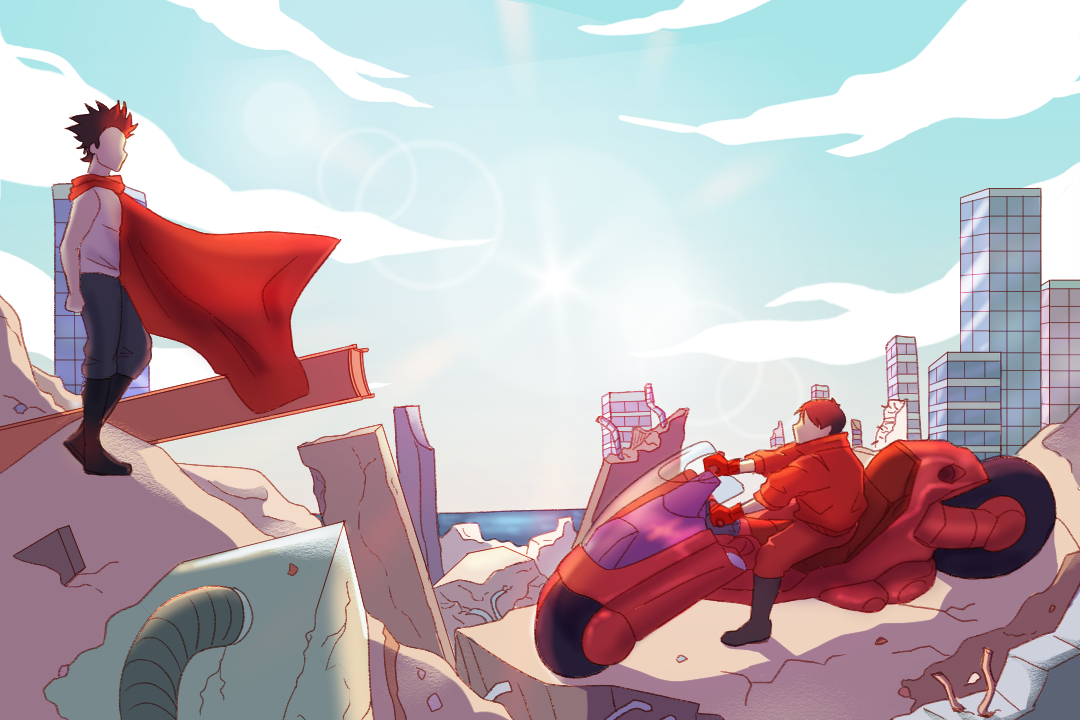July 16, 1988: In an instant, a flash of light engulfs half of Tokyo. It dissipates as quickly as it came, leaving in its wake a crater stretching out over several miles that punctuates the once-busy city core. 30 years later, Neo-Tokyo is still reeling in the aftermath of a Third World War.
Tensions are high; riots are ongoing as police violently fend off student protestors angered by rising taxes and unemployment. Elsewhere, swathes of Tokyo’s neighborhoods are dilapidated, catering to the vices of the local criminal underbelly and restless cyberpunk youth biker gangs.
This setting is the backdrop of Akira, a film directed by Katsuhiro Otomo and based on his 1982 manga of the same name. The story followed Shotaro Kaneda — who leads a biker gang named “The Capsules” — and his childhood friend, Tetsuo Shima. When an accident during a night out becomes a catalyst for awakening latent supernatural abilities in Tetsuo, the duo unwittingly finds themselves in the crosshairs of a corrupt and mostly incompetent government.
Its story even feels relevant today — Akira also alluded to preparations for a 2020 Olympic games in Neo-Tokyo that are the subject of in-story protest and riots. Whether this was a premonition or pure coincidence, it created an unlikely parallel to this year’s summer Olympics in Tokyo, when health experts and locals argued that the world wasn’t ready for an event while fending off an ongoing pandemic.
Outside of relatively niche discussion circles and die-hard fans, you’d be hard-pressed to find anyone with remote knowledge of the film’s existence. However, Akira exerted a revolutionary influence on art, filmography, video games, and music. Most people are probably familiar with at least one work which drew direct inspiration from Akira.
The film itself was noteworthy in part because its production was an undertaking of unprecedented ambition. More than 150,000 animation cells were painstakingly drawn for the film. They resulted in a smoothness to the film’s animations, even by today’s standards: characters and vehicles glided seamlessly through scenes and settings. Action scenes were poised, punchy, and poignant.
The film’s emphasis on lighting for its visuals was also significant. From fiery chalk-white explosions to computers and dingy neon signs that bathed their surroundings in an artificial fluorescent green, Akira’s lighting techniques helped guide the characters — and, by extension, the viewers — through the patchwork of landscapes constituting Neo-Tokyo.
These visual effects were complemented by the film’s superb soundtrack, which featured Indonesian gamelan and traditional Japanese noh music. The combination of impressive visuals and music created an immersive sensory experience.
Thematically, the film was far more than a science fiction story laced with elements of cyberpunk. It was densely packed, touching on subjects ranging from corruption and anarchy to the ethics of scientific research, family, and transcendence.
The film’s attention to these concepts, while significant for its time, seemed to barely scratch their surface. This likely had to do with the fact that the manga was more than 2,000 pages, and had to be drastically cut to feature only major scripted events from the plot’s beginning and end.
Akira has become a cornerstone of the science fiction genre and animation. The film represented a paradigm shift in the progression of Japanese animation, and many subsequent works emulated its revolutionary production techniques or outright paid homage to it.
This influence has extended to practically every crevice of modern culture. John Gaeta, for instance, has pointed to the film as having impacted the creation of the famous bullet time sequences from The Matrix. Cyberpunk 2077, Metal Gear Solid, South Park, Stranger Things, Kill Bill, Rick and Morty, The Dark Knight, streetwear brand Supreme, Steven Spielberg, and even Kanye West have also all referenced or cited Akira as a direct inspiration.
Though at first notice, Akira seems like an outdated anime, its influence is noticeable in aspects of present-day pop culture. The anime serves as a source of inspiration for artists, proving that, more than 30 years after its release, the anime’s messages are still pertinent to our times.


